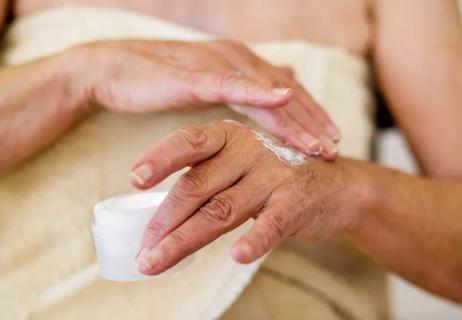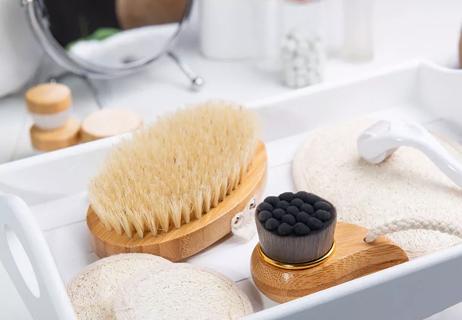Deal with dry skin by preserving your skin’s moisture, using moisturizing products and taking preventive action

Dry skin can be a nuisance. It can be painful, itchy and flake off on your clothing. Or it may be red and scaly, causing you to feel embarrassed. And when you have dry skin on your face — where all the world can see it — you may be especially motivated to treat it.
Advertisement
Cleveland Clinic is a non-profit academic medical center. Advertising on our site helps support our mission. We do not endorse non-Cleveland Clinic products or services. Policy
Dry skin can happen to anyone, at any age and for any number of reasons, says dermatologist Jennifer Lucas, MD. But with a couple of skin care tips and some small changes to your daily routine, you can improve your skin’s moisture and prevent dry skin from coming back.
Dr. Lucas explains why dry skin happens and what you can do to take care of it (gently).
One cause of dry skin is aging. Your skin naturally loses moisture as you age. So by around age 60, most people have dry skin.
But there are several reasons you may experience dry skin at younger ages, including:
Advertisement
Whether your skin has a couple of dry patches or feels like the Sahara Desert, you can improve the situation. The goals of dry skin treatment are to:
The treatment needed to improve dry skin can vary depending on how dry it is and the cause. Dr. Lucas typically recommends these steps:
Your skin’s moisture naturally diminishes as you age. The amount of oil (sebum) your skin produces drops dramatically around age 40. That’s why retaining the moisture your skin produces is critical at any age — especially when you have a dry complexion.
To hold on to your skin’s moisture:
“Taking even small steps, like using cooler water whenever possible, can help soothe dry skin and go a long way toward helping retain the skin’s moisture,” Dr. Lucas says.
Moisturizing multiple times daily is key to reducing and preventing dry skin on your face. Follow a skin care routine and apply moisturizer immediately — within five minutes — after washing your face.
For an added benefit, Dr. Lucas recommends choosing a moisturizer that contains ingredients like:
“There are a lot of fancy products out there, but you just need a moisturizer that gives you back some of the moisture your skin naturally loses,” she adds. “You can find products with these ingredients right in the drugstore.”
For severe dry spots, add immediate moisture with a petroleum jelly-based product. Dab it gently on your dry spot before bed, and it can help replenish moisture quickly. If your entire face feels dry, you may want to try slugging — slathering your whole face with a thin layer of petroleum jelly. If you notice that you start to get pimples with this regimen, you may need to discontinue or limit its use.
Advertisement
When you see dry skin, your first instinct may be to exfoliate and remove the flakiness. But be careful, warns Dr. Lucas. Many exfoliation products can do more harm than good.
“A lot of times, you’re stripping away what you think is dry skin,” she says. “But it takes off more than you expected. Now, you have to heal the newly damaged skin. If you continue to exfoliate, you may be setting yourself up for a very repetitive (and irritating) cycle.”
Dry skin is extra sensitive, so take a gentle approach. Pat your skin dry and use a soft touch when washing and moisturizing.
Whether you have chronic dry skin or just noticed a new dry patch, look closely at the products you use on your face and the ingredients in those products. And don’t just look at your moisturizer and cleanser, advises Dr. Lucas. Makeup and shampoo can also cause dry skin.
On the skin care front, be sure to choose products made specifically for the face. Those products should be fragrance-free, which is different from being unscented. Unscented products often still contain the same irritating chemicals as fragrant products.
“To prevent the signs of aging, we often turn to retinol. But this may dry out your skin,” Dr. Lucas says. “Try to find the balance between products that keep you youthful and those that keep your skin moisturized. Some products, like those containing hyaluronic acid, can counterbalance the dryness of retinol.”
Advertisement
It doesn’t matter whether your climate is sunny and hot or gray and cold. Keeping your skin safe from damaging weather and environmental dangers is crucial.
Your skin can sustain damage and dry out with exposure to:
“Make smart skin choices when you’re younger to avoid having dry skin when you’re older. Protect your skin and avoid damaging UV rays,” Dr. Lucas says. “No matter where you live, choose a daily moisturizer that contains sunscreen. And be sure to shield your skin from the sun and cold air.”
Scaly, dry skin is often the result of a lifetime of skin damage from UV rays and harsh products.
“As we age, the damage builds up,” Dr. Lucas explains. “There are things we can do to treat mature skin, but those treatments typically require the care of a dermatologist.”
Treatments for damaged skin include:
Advertisement
“There are many options for removing damaged skin cells and reinvigorating healthy skin,” Dr. Lucas says. “It just depends on the nature of the damage.”
Treating the underlying skin condition or health condition that’s causing your dry skin will help alleviate the problem.
Health conditions that may cause dry skin include:
“If dryness is a sign of a more serious issue, you’ll usually have dry skin elsewhere — not just on your face,” Dr. Lucas clarifies. “In many cases, you’ll also notice other symptoms, such as body aches or joint pain.”
If you haven’t been diagnosed with an underlying medical condition, but suspect you may have one, speak to your primary care provider about your concerns.
You can treat most dry skin issues at home with simple tweaks to your face care regimen. But if your dry skin sticks around, a dermatologist or other healthcare professional may be able to speed up the process or identify an underlying cause.
“Most facial dryness can be remedied, but there are cases where it’s best to have your provider take a look,” Dr. Lucas notes.
Contact a healthcare provider if your dryness is:
“Your provider can also help you keep dry skin from happening again,” Dr. Lucas says. “The key to healthy, supple skin is prevention. Prioritize moisture at every age and help your skin manage the side effects of aging by wearing sunscreen daily.”
Learn more about our editorial process.
Advertisement

Choose cream for your body and lotion for your face, and skip the fragrances and botanicals

Get tips for doing it correctly from a dermatologist

It’s a great disinfectant for around your home, but not for your skin

Changes in texture, smell, color and performance are signs it’s time to throw the cosmetic item away

Follow the 4Cs — cooling, cleaning, covering and comforting — to start the healing process

Bathing once a day is the general guidance, but you could also have reasons to soap up twice a day or not at all
There’s not one specific cure-all diet for eczema, but it helps to keep track of what you eat and when you experience symptoms

It’s best to avoid picking at zits, which can damage your skin (though there are ways to minimize the risk)

You can improve your athletic performance over time by breaking up your workout regimen into focused cycles

The little blue pill might help with physical arousal, but there are better treatments for low libido in women

Sleep issues and certain foods can lead to an early morning headache